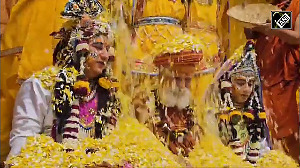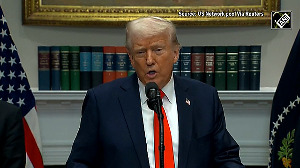'With butterflies in our stomachs, but confident of our mission, we took off for Jaffna on the morning of 24 July 1987.'
IAF Veteran Air Commodore Nitin Sathe recalls a conversation with Air Vice Marshal Harpal Singh Ahluwalia (retd), then a wing commander and mission leader for the clandestine operation.

I got to speak to Indian Air Force Veteran Air Vice Marshal Harpal Singh Ahluwalia in Wellington in the Nilgiris.
I was, at that time, researching on the Indian Peace Keeping Force and the Indian Air Force's role in the IPKF operations in Sri Lanka which began in 1987, and lasted almost three years.
The air vice marshal remembered events clearly as if they happened yesterday and was forthcoming in his description of the clandestine mission that was undertaken on July 24, 1987.
36 years ago, a secret mission this day
"In the cacophony of the rotors, we waited excitedly for the passengers to arrive, also aware that that bullets could fly any moment, jeopardising the entire mission."
The helicopters were at full RPM (Revolutions Per Minute), ready to fly out if such an eventuality happened. There were to be just four VIP passengers along with a few staff, the crew had been briefed.
Six new gleaming Mi-17 helicopters of the newly formed helicopter unit at Hindon (Ghaziabad) had been tasked to ferry out at short notice for a mission that they weren't aware of or briefed for, when they took off for the long 2,000 km plus ride from north to south.
"You will be briefed for the mission when you reach Sulur (Coimbatore)," the Chief Operations Officer at the parent base had told them.
It was the 22nd of July 1987, and the choppers took off at sunrise, heading south towards Khajuraho, on the first leg of their long flight.
"It was exciting as well as intriguing at the same time," recalls Air Vice Marshal 'Harry' Ahluwalia.
He was a wing commander then, heading this new unit and also awaiting his next rank.
Harry sir is now in his late seventies, settled in Wellington, which is home to the Defence Services Staff College.
"I was told that the helicopters must be ready and equipped for Special Heliborne Operations (SHBO), somewhere in the south, at the earliest."
Sri Lanka was in the midst of a bloody civil war.
J R Jayewardane, then the Sri Lankan president, had ordered his army into Jaffna, the stronghold of the Liberation Tigers of Tamil Eelam.
Sri Lankan troops had gone on a rampage in the Tamil dominated town with heavy weapons and more than a thousand civilians had been killed.
The outrage over events in Jaffna and northern Sri Lankan has spilt over to Tamil Nadu.
The urgency of the mission, and the SHBO task that they were asked to be ready for made the Commanding Officer realise that the mission had something to do with Sri Lanka.
As the commanding officer of the Hindon unit Wing Commander 'Harry' Ahluwalia understandably was the mission leader.
He had undertaken operations against militancy during the Mizo crisis, the lessons learnt there would be helpful in planning this mission well.
The aircraft had reached Sulur on the noon of July 23rd, but they were soon asked to fly further south to Thanjavur, to a small disused airfield at that time, under IAF control.
"Thanjavur was a ramshackle airfield with no accommodation in those times and we spent the evening getting rid of the tiredness of the long flight at a hotel," remembers 'Harry' Sir.
The next morning things became clearer, when, in a joint briefing by Army and Air HQ representatives, a detailed briefing was carried out.
Two aircraft were to fly out from Thanjavur, go across the sea flying at deck level and enter Sri Lankan territory to land near a temple just outside Jaffna to pick up some passengers and get them back to mainland India in a clandestine mission.
And who were these VIP passengers? Vellupillai Prabhakaran, the LTTE leader, his wife and two children along with some other Tigers.

The LTTE supremo's strongholds in Jaffna had taken a severe pounding from the Sri Lankan army. Maybe, just maybe, he was coming to India to ask for help, everyone in the crew thought.
During the briefing, a crew member asked the HQ reps, "What happens if we come face to face with the Sri Lankan army on landing at Jaffna?"
"Should such an eventuality arise, you are to tell them to call up their President and take orders," came the reply.
"We weren't too amused with the answer, but decided not to question the senior officer," says Harry sir.
"With butterflies in our stomachs, but confident of our mission, we took off for Jaffna on the morning of 24 July 1987."
An LTTE representative was on board to help them navigate to the temple at Jaffna.
"This man in the aeroplane was of no use to us or anyone else. Firstly, he did not speak a word of Hindi or English; and secondly, he was totally disoriented the moment we were off the ground," remembers the AVM.
The outbound leg went without a hitch. Two additional Mi-17s were also airborne and orbiting near the coast as airborne standbys, while the other helicopters remained on ground.
An An-32 aircraft climbed high over the coast and acted as a radio relay, since radio range at low altitudes would be poor.
The officers in Delhi, obviously, wanted a minute to minute progress report of the mission.

Harry Sir and his crew arrived at the temple in Jaffna and the passengers were quickly put on board along with their escorts.
The crew then asked Prabhakaran's security detail to hand over their weapons for safe custody ,which was very reluctantly agreed to.
Just as the helicopter was going to lift off, the flight engineer noticed a weapon -- an AK 47 most probably -- lying on the ground close to the aircraft.
"He was keen to go and pick it up as a trophy to be kept at the unit, but better sense prevailed. I negated his request and we got ready for take-off," says Harry Sir.
What if the passengers thought that the weapon was a threat to their leader when the engineer bought it into the passenger cabin?
The LTTE was capable of drastic action. The entire mission would have been jeopardised.
Up and away, and heading towards the Indian coastline, the crew were happy that the mission had gone off without a hitch.
"We had carried a camera on board and the flight gunner took a few photographs of the passengers which were to be kept for posterity, much against the wishes of Prabhakaran's security staff," remembers the mission leader.
The photographer at the studio later reported that the entire film had been over exposed and there was nothing for him to print.
Apparently, one of the passengers had opened the rear end of the camera and exposed the reel during the flight when the gunner was busy doing his duties!
"We got Prabhakaran to write something for us. 'My best wishes to the Indian People', he wrote in Tamil and signed below it. That memento is still available in the squadron diary to this day," says Harry Sir.
The mission, amidst tight security, landed in Trichy and the passengers were transferred to a waiting An-32 which was to take them first to Chennai and then onwards to Delhi.

In a few days, it is believed that Prabhakaran and his family were back in Jaffna. What happened in Delhi is not known.
Just five days after this mission, on July 29, 1987, the Indo-Sri Lanka accord was signed by then prime minister Rajiv Gandhi and Jayewardane in Colombo.
The very next day, the Indian Army -- the Indian Peace Keeping Force -- moved into the island nation for a bloody tenure which was to last 32 months.
A helicopter pilot who served the IAF for 35 years, IAF Veteran Air Commodore Nitin Sathe is a frequent contributor to Rediff.com and you can read his earlier articles here.
Feature Presentation: Aslam Hunani/Rediff.com











 © 2025
© 2025